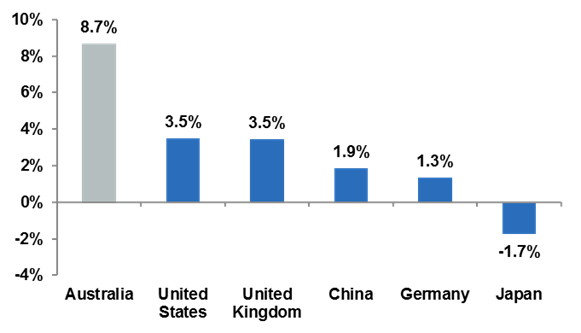Invest
What Australia’s population growth means for property
Following Australia’s pause to count our population via the somewhat maligned census, it’s timely to contemplate the role of population growth in investing for retirement and our obsession with residential real estate.
What Australia’s population growth means for property
Following Australia’s pause to count our population via the somewhat maligned census, it’s timely to contemplate the role of population growth in investing for retirement and our obsession with residential real estate.

Despite the great capital gains many homeowners have achieved in the last few years, it’s a brave investor who would now wade into the Sydney or Melbourne residential property markets with the sole aim of achieving an attractive return.
Sure, buy a house or apartment because that’s where you want to live. But if you are looking for a stable investment, looking further afield to investment grade commercial property is likely to be a better bet.
There is currently an explosion in apartment building in the major capital cities, and at the same time the RBA has warned against a housing bubble, the big banks have cut bank lending for international buyers of new Australian apartments.
Yields on residential property after generally very low, anything from around the 2 to 3 per cent after you take into account the holding costs including rates, services and land tax.

By comparison, an interest in investment grade commercial property through leading Australian investment property managers can be purchased via the stock exchange or through unlisted property trusts with the expectation of 6.5 to 7.5 per cent per annum plus capital growth, without any of the expenses associated with residential property.
Where does population growth fit in?
Population is a significant driver of economic growth. And economic growth is a driver of commercial property prices. According to the Australian Bureau of Statistics, the Australian economy grew at an annual pace of 3.2 per cent in the 1990s of which nearly half – or 1.5 per cent – was contributed by population growth.
In the first decade of the new millennium, Australian economic growth increased to around 4 per cent per annum, of which 1.8 per cent was attributed to population growth.
The International Monetary Fund population projections have Australia significantly above the US, the UK, China, Germany and Japan.
This may come as a surprise to the average Australian who tends to think we have a low population growth compared to many OECD countries, but we don’t.
Chart: Population growth

Source: Charter Hall Analysis of IMF WEO Oct-16 Data
The graph above shows our lead in the population stakes, and basically it is all good news. Increases in population fuel economic growth and economic growth in general is a major positive for property prices.
This is one of three factors which led many observers to believe the outlook for high quality commercial properties in Australia has a bright future in terms of income yields and capital growth.
The other factors are the relatively strong economic growth being experienced in the two key commercial property markets of Sydney and Melbourne, and finally, the subdued value of the Australian dollar, which makes Australian commercial property attractive to foreign buyers.
Nick Kelly, head of direct property, Charter Hall

Property
New investment platform Arkus allows Australians to invest in property for just $1
In a groundbreaking move to democratise investment in property-backed mortgage funds, GPS Investment Fund Limited has launched Arkus™, a retail investment platform designed to make investing ...Read more

Property
Help to Buy goes live: What 40,000 new buyers mean for banks, builders and the bottom line
Australia’s Help to Buy has opened, lowering the deposit hurdle to 2 per cent and aiming to support up to 40,000 households over four years. That single policy lever will reverberate through mortgage ...Read more

Property
Australia’s mortgage knife‑fight: investors, first‑home buyers and the new rules of lender competition
The mortgage market is staying hot even as rate relief remains elusive, with investors and first‑home buyers chasing scarce stock and lenders fighting for share on price, speed and digital experienceRead more

Property
Breaking Australia’s three‑property ceiling: the finance‑first playbook for scalable portfolios
Most Australian investors don’t stall at three properties because they run out of ambition — they run out of borrowing capacity. The ceiling is a finance constraint disguised as an asset problem. The ...Read more

Property
Gen Z's secret weapon: Why their homebuying spree could flip Australia's housing market
A surprising share of younger Australians are preparing to buy despite affordability headwinds. One in three Gen Z Australians intend to purchase within a few years and 32 per cent say escaping rent ...Read more

Property
Tasmania’s pet-positive pivot: What landlords, BTR operators and insurers need to do now
Tasmania will soon require landlords to allow pets unless they can prove a valid reason to refuse. This is more than a tenancy tweak; it is a structural signal that the balance of power in rental ...Read more

Property
NSW underquoting crackdown: the compliance reset creating both cost and competitive edge
NSW is moving to sharply increase penalties for misleading price guides, including fines linked to agent commissions and maximum penalties up to $110,000. Behind the headlines sits a more ...Read more

Property
ANZ’s mortgage growth, profit slump: why volume without margin won’t pay the dividends
ANZ lifted home-lending volumes, yet profits fell under the weight of regulatory and restructuring costs—an object lesson in the futility of growth that doesn’t convert to margin and productivityRead more

Property
New investment platform Arkus allows Australians to invest in property for just $1
In a groundbreaking move to democratise investment in property-backed mortgage funds, GPS Investment Fund Limited has launched Arkus™, a retail investment platform designed to make investing ...Read more

Property
Help to Buy goes live: What 40,000 new buyers mean for banks, builders and the bottom line
Australia’s Help to Buy has opened, lowering the deposit hurdle to 2 per cent and aiming to support up to 40,000 households over four years. That single policy lever will reverberate through mortgage ...Read more

Property
Australia’s mortgage knife‑fight: investors, first‑home buyers and the new rules of lender competition
The mortgage market is staying hot even as rate relief remains elusive, with investors and first‑home buyers chasing scarce stock and lenders fighting for share on price, speed and digital experienceRead more

Property
Breaking Australia’s three‑property ceiling: the finance‑first playbook for scalable portfolios
Most Australian investors don’t stall at three properties because they run out of ambition — they run out of borrowing capacity. The ceiling is a finance constraint disguised as an asset problem. The ...Read more

Property
Gen Z's secret weapon: Why their homebuying spree could flip Australia's housing market
A surprising share of younger Australians are preparing to buy despite affordability headwinds. One in three Gen Z Australians intend to purchase within a few years and 32 per cent say escaping rent ...Read more

Property
Tasmania’s pet-positive pivot: What landlords, BTR operators and insurers need to do now
Tasmania will soon require landlords to allow pets unless they can prove a valid reason to refuse. This is more than a tenancy tweak; it is a structural signal that the balance of power in rental ...Read more

Property
NSW underquoting crackdown: the compliance reset creating both cost and competitive edge
NSW is moving to sharply increase penalties for misleading price guides, including fines linked to agent commissions and maximum penalties up to $110,000. Behind the headlines sits a more ...Read more

Property
ANZ’s mortgage growth, profit slump: why volume without margin won’t pay the dividends
ANZ lifted home-lending volumes, yet profits fell under the weight of regulatory and restructuring costs—an object lesson in the futility of growth that doesn’t convert to margin and productivityRead more








